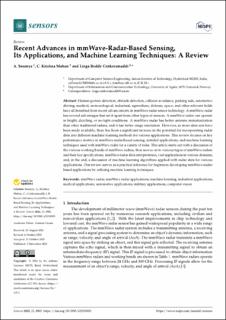Recent Advances in mmWave-Radar-Based Sensing, Its Applications, and Machine Learning Techniques: A Review
Peer reviewed, Journal article
Published version
Permanent lenke
https://hdl.handle.net/11250/3102167Utgivelsesdato
2023Metadata
Vis full innførselSamlinger
Originalversjon
Soumya, A, Mohan, C. K. & Cenkeramaddi, L. R. (2023). Recent Advances in mmWave-Radar-Based Sensing, Its Applications, and Machine Learning Techniques: A Review. Sensors, 23 (21). https://doi.org/10.3390/s23218901Sammendrag
Human gesture detection, obstacle detection, collision avoidance, parking aids, automotive driving, medical, meteorological, industrial, agriculture, defense, space, and other relevant fields have all benefited from recent advancements in mmWave radar sensor technology. A mmWave radar has several advantages that set it apart from other types of sensors. A mmWave radar can operate in bright, dazzling, or no-light conditions. A mmWave radar has better antenna miniaturization than other traditional radars, and it has better range resolution. However, as more data sets have been made available, there has been a significant increase in the potential for incorporating radar data into different machine learning methods for various applications. This review focuses on key performance metrics in mmWave-radar-based sensing, detailed applications, and machine learning techniques used with mmWave radar for a variety of tasks. This article starts out with a discussion of the various working bands of mmWave radars, then moves on to various types of mmWave radars and their key specifications, mmWave radar data interpretation, vast applications in various domains, and, in the end, a discussion of machine learning algorithms applied with radar data for various applications. Our review serves as a practical reference for beginners developing mmWave-radar-based applications by utilizing machine learning techniques.

